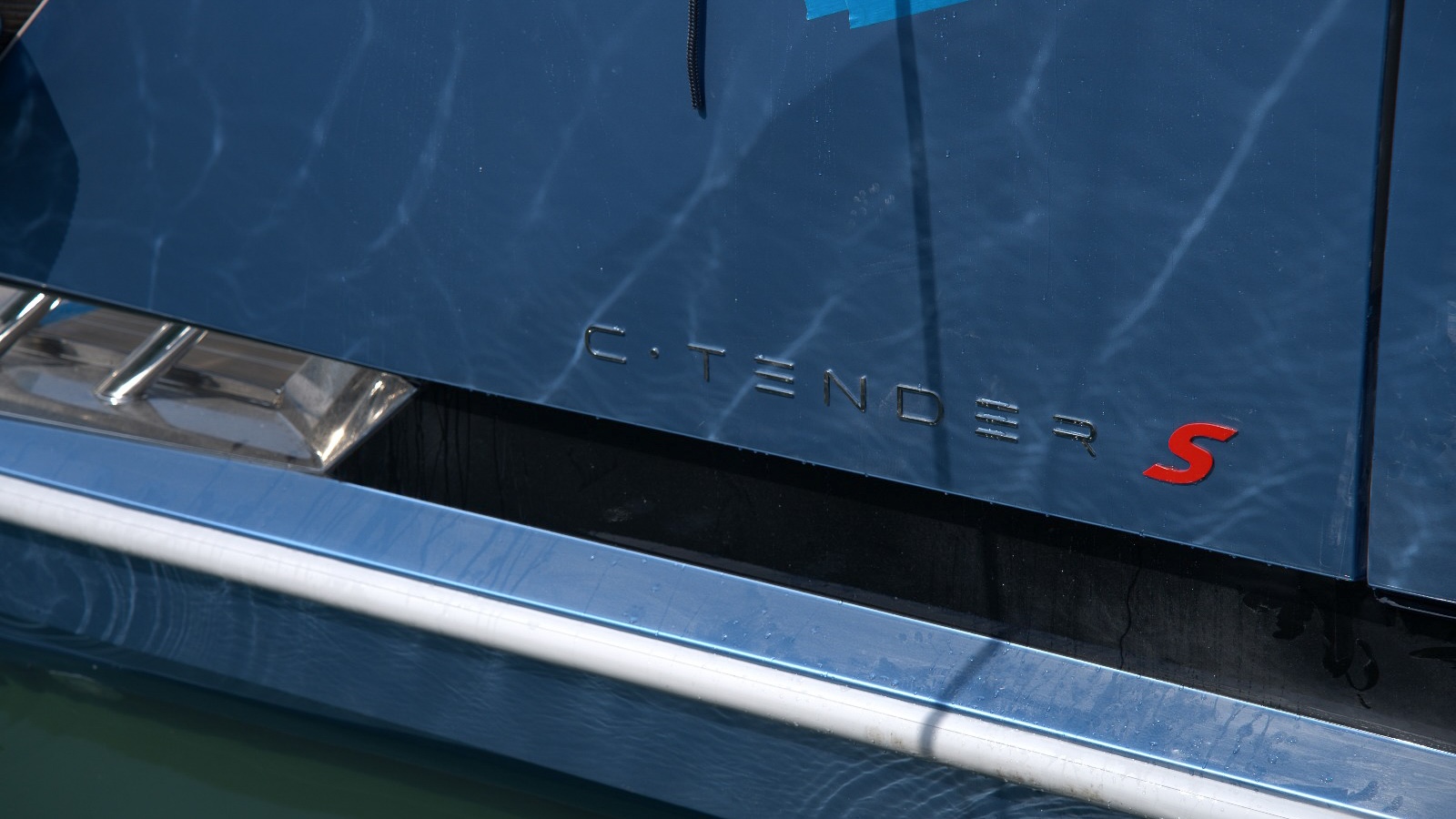Boat Engine Maintenance: can you perform it yourself without a professional?
The answer is certainly yes, it’s not a complex operation, you just need to take some important details into account.
Regularly performing maintenance will also ensure that your engine remains in the best possible condition and reduce the risks of mechanical failures. Learning to perform a boat engine maintenance by yourself will also give you greater familiarity with the components of your boat and save money on maintenance costs.
In the following guide, we will only focus on boats equipped with small to medium power diesel inboard engines, namely small displacement motorboats and most sailboats.
DIY Boat Engine Maintenance: differences between sailboats and motorboats
In addition to the differences in style, structure, and performance between sailboats and motorboats, there are also slight differences in engines. For instance, motorboats may be powered by gasoline, while others may not have a heat exchanger. In other words, each boat has its own peculiarities, and before starting the boat engine maintenance, it’s certainly useful to download the manual of your model to understand clearly how the various components function.
Tools and materials needed for performing boat engine maintenance
Here’s a detailed and reliable list of the basic tools and materials needed to perform engine maintenance on a boat:
Tools:
Socket wrenches and adjustable wrenches of various sizes for removing bolts and screws;
Hex keys of various sizes for hexagonal screws;
Phillips and flathead screwdrivers of various sizes;
Ratcheting screwdrivers for working in hard-to-reach areas;
Torque wrenches for tightening bolts to the correct torque;
Regular pliers and long-nose pliers;
Hammer for emergencies;
Oil pump for extracting used engine oil;
Work gloves to protect hands;
Lamp or flashlight to illuminate dark and hidden areas of the engine.
Materials:
Specific motor oil for your engine;
Replacement oil filter;
Replacement fuel filter;
Coolant (if necessary);
Greases and lubricants for lubrication points;
Distilled water for the cooling system (if necessary);
Clean cloths for wiping any oil or liquid drips (oil-absorbing cloths recommended).
DIY Boat Engine Maintenance: Step-by-Step Guide
Performing the boat engine maintenance is essential to keep the engine in excellent condition. The steps include visual inspection, replacing filters and impeller, changing oil, and checking the cooling system. Let’s see them in detail.
1. Preparation
Obtain the manual for your engine, gather all the tools and materials mentioned above, and ensure your boat is in a safe and stable location for maintenance.
2. Visual Inspection
Unlike car engines, boat engines are usually painted in a solid color. This is done so that any leaks can be easily seen. Abnormal oil leaks are immediately noticeable due to the contrast between the engine paint and the color of the liquid.
During the visual inspection, check for any oil leaks, coolant leaks, or water leaks (from the cooling system). If you notice an abnormal presence of water, you can resort to the oldest and most reliable test to determine if it is fresh or saltwater: dip a finger and taste it.
3. Engine Oil Change
The first step in your boat engine maintenance will be to remove the used oil. To drain the old oil, it’s advisable to run the engine for about ten minutes before the operation. This will make the oil less viscous, making it easier for you to extract.
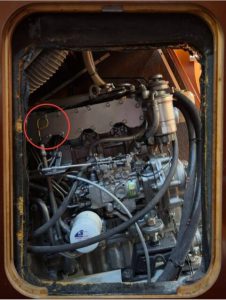
The pump can be inserted where you check the oil level, provided that you ensure it’s drawing from the bottom of the engine crankcase.
Of course, throughout this process, the oil fill cap must remain open to prevent negative pressure.
The second step is removing and replacing the oil filter. To do this, you’ll need to unscrew the old filter, if possible using a strap wrench.
Theoretically, the filter should be removed by hand, without the need for wrenches. Unfortunately, it’s rarely tightened correctly, so when it comes time to open it, the filter is often too tight and difficult to unscrew.
Every boat filter has an OEM code printed on it that provides guidance on which model to purchase: this code comes useful if you prefer not to buy the part directly from the official dealer but opt for one from another brand. To seal the filter, it’s recommended to run a finger of engine oil over the rubber gasket of the filter itself to lubricate it, and then tighten it by hand. This will ensure easy opening during the next filter change and save you time and effort.
After draining the used oil and changing the filter, you’ll need to pour the new oil into the tank. The oil must be the one indicated by the manufacturer, as there are different types with varying viscosity.
Transmission Oil Replacement
If it’s time to change the transmission oil as well, the operation is the same. You need to remove the cap, extract the used oil, pour in the new one, making sure to use the correct brand of oil and lubricate the gasket with a finger before screwing it back on.
4. Replacement of Fuel Filters
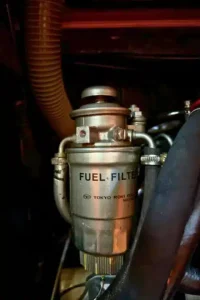
First of all, if you have it onboard, remember to close the diesel valve at the tank outlet. Then, carefully unscrew the top cap to avoid spilling fuel around. You can use a plastic bag positioned under the cap to catch any fuel leaks.
To remove the bottom cap, you can try by hand or use a strap wrench. Once the cap loosens, place the bag underneath and continue unscrewing by hand: this way, any diesel leaks will be collected in the bag, keeping your boat clean.
Once opened, replace it with the new one. Optionally, you can fill the new fuel filter with diesel (it’s a glass, after all). As with changing the oil filter, you can lubricate the gasket with diesel to facilitate opening.
5. Engine Impeller Replacement
Before opening the impeller compartment, remember to close the engine’s seawater intake because the impeller is likely below sea level. If you don’t close it, there’s a risk of water ingress. My advice is to place a tray underneath because as soon as the impeller is opened (by unscrewing its bolts), saltwater that has accumulated may spill, and without a tray underneath, it could spread throughout the engine. Those familiar with marine environments know that the less saltwater that comes into contact with the engine, the better.
If the impeller is intact, the operation is simple: using an extractor or two long-nose pliers, gently remove it from its housing.
If the impeller fragments upon extraction, remove all the pieces to prevent them from damaging the new one once it’s installed. Lastly, when inserting the new impeller, remember to check its direction of rotation.
An important note is to use the product (liquid vaseline) provided with the new impeller. Do not use oil, grease, or other products not supplied with the impeller because during the initial moments of engine startup, the impeller runs dry (as it’s been replaced), and if the correct lubricant isn’t used, it risks burning out before receiving water.
6. Belt Replacement
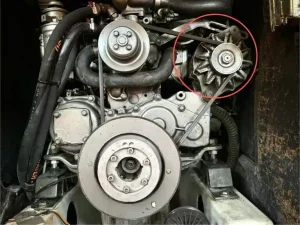
After removing the belt, make sure to clean the entire surrounding area so that after installing the new one, you can immediately notice if more black dust forms. If you find any, it means something is misaligned, and at that point, you should call a mechanic.
To remove and install the belt, you need to loosen the alternator and position it so that there’s about 1 cm of play. If it’s too tight, it risks breaking the pulleys; if it’s too loose, it vibrates and wears down, creating the above-mentioned black dust.
7. Coolant Replacement
In most boats, under the heat exchanger, there’s the coolant tank valve. Unscrew it using an adjustable wrench while simultaneously opening the cap at the top of the tank. By doing this, the air intake will allow the old coolant to drain out from the valve.
Place a basin or tray underneath to collect the old coolant. Once the tank is emptied, close the valve and pour in the new coolant through the cap. The coolant must be compatible with the one already present; they are usually color-coded, typically yellow/green, red, and blue. Each engine has its specific coolant, and it’s important to follow the manufacturer’s recommendation. If you don’t want to buy the official brand, you can purchase one from another brand with the same color.
Final steps
Before finishing your boat engine maintenance, your hands will be dirty, the engine will be disassembled, and it will be hot (because even in winter, the engine compartment is always warm), and you’ll be eager to test your work with the first start-up. That’s the moment when you need to check that all caps are closed, bolts tightened, and liquids in their respective places.
Equip yourself with a brake cleaner or industrial degreasing spray: it’s a highly degreasing product that evaporates within minutes of use. This is necessary because after completing the boat maintenance, you’ll see oil drops everywhere. The spray, along with a cloth for wiping, will greatly assist you in thoroughly cleaning the entire engine compartment. Eliminate every trace of dirt; it’s incredibly important to be able to see if there are any leaks later on.
First start-up after completing boat engine maintenance: bleeding
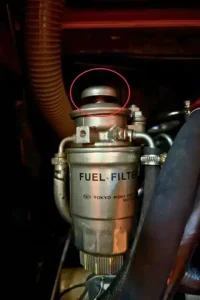
Using an adjustable wrench, loosen the bleed screw located on the injection pump next to the nuts that secure the rigid lines carrying fuel to the injectors, and use pump C to purge the air from the system.
This pump is used to manually draw diesel fuel with the engine off. Pump C is an integral part of the engine and is often integrated into the fuel filter bracket. However, each engine has its own system, and consulting the boat‘s manual can be helpful.
Air will escape from the slot you’ve opened until diesel fuel begins to flow. Only at that point should you close everything, clean with industrial degreasing spray, and start your brand-new engine. You’ve just completed your first boat engine maintenance.























